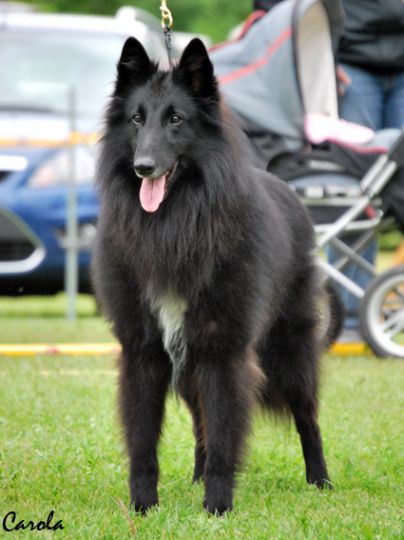|
|
1 |
2 |
3 |
4 |
5 |
|
1)Social skills. The dogs meetingprogram
and approachability. |
Avoids contact with
strangers aggressively
|
Avoids contact with strangers.
|
Accept contact with strangers. |
Accept contact with
strangers when for example the handler
makes contact.
|
Makes contact in an
excessively manner
|
|
2)Play (Preydrive, fight)
The dogs willingness to
engage in play, chase. |
Avoids invitation to play
or does not play. |
Slow start, gets active
in short intervals. |
Gets going easily,
shifting between activity and passivity. |
Starts quickly, intense
in play. Difficult to stop, may turn
into a tug of war. |
Iinitialize
play, goes quickly into tug of war, does
not stop
|
|
3) Social skills Dogs willingness to go
into battle. |
Does not respond to the
challenge. May want to flee |
Responds to the
challenge, replies, low intensity. |
Responds to the
provocation, replies, low intensity.
|
Responds quickly when
challenged, replies with high intensity. |
Responds immediately to
the challenges, replies very quickly,
show attack. |
|
4) Social dominans
|
Does not show any signs
of dominance throughout the test.
(submissive), or any dominance signs
without being provoked. |
May show small signs of
dominance when playing.
|
Shows moderate signs of
dominance, correct response through one
or several moments, more intense in
play.
|
Shows pronounced signs of
dominance through several moments of the
test, and relatively early in the test.
|
Shows consistent signs of
dominance at the start of each moment.
|
|
5)Preydrive/ chase Dogs willingness to
find/catch prey
|
Shows
no interest.
|
Starts, but does not
follow through. |
Starts with delay,
increased interest, follow through.
|
Starts, focused,
interested in the prey. |
Starts quickly, high
speed, tends to block out. |
|
6)Preydrive/interest Dogs ability and
intensity in grabbing the prey
|
No
preydrive |
Slow interest, noses on
the prey. Do not grab. |
Grabs prey with delay,
release quickly |
Target and grab prey, brings it along.
Finishes. |
Jumps in, grabs prey –
somewhat unbalanced. |
|
7) Defense Dogs willingness to stop
an intruder
|
Do not engage, can show flight and
tendency to flee
|
Mild defensive, can vary
between prevention, passivity or flight
|
Engage in effective defense, correct
intensity.
|
Defend itself with
intense increasing engagement.
|
Defend itself with great intensity from
the moment starts.
|
|
8)
Development Intensity
and speed
|
No visible
reaction
|
Shows only parts of its
defense mode, contact or dominance. Can
move directly into flight or attack |
Shows increasing
intensity through the contact and
dominance program
|
Rapidly shows intensity in its defense
program
|
Awaits, goes directly
into attack mode
|
|
9) At what point of
pressure will the dog show flight or
attack |
Shows immediate flight or
attack reaction
|
Shows
flight/attack
at 1/3
of the distance.
|
Shows flight/attack at ½
of the distance |
Shows flight/attack at
territorial border |
No flight or attack reactions
|
|
10)Abreaction Dogs ability to regain
balance after pressure |
Do
not
abreact
|
Abreact, but uses too
much time at some of the moments
|
Abreact, and the abreaction is in line
with the reaction. |
Abreact to quickly |
Shows no reaction and no
abreaction |
|
11) Concentration Dogs ability to stay
focused. Attention span |
Breaks the attention
quickly both with passive and active
influence. Impulsive |
Breaks the attention
somewhat quickly with passive or active
influence
|
Keeps attention as long
as there is motive
|
Tendency to block at some
of the moment
|
Blocks |
|
12) Coordination Correct reaction between
and towards the influence |
Acts irrationally in most
of the test situations and between the
test situations
|
Acts irrationally in most
of the test situations
|
Solves some of the
moments rationally |
Solves most of the
moments rationally. |
Correct reaction and
action with full control
|
|
13)Temperament How quickly does the dog
adapt to its surroundings
|
No reaction in test
situations, can be unengaged.
|
Somewhat attentive,
responds with delay toward the
influence, and adapt a bit slow in the
test situations
|
Attentive, responds
quickly in most situations. Adapt to the
test situation.
|
Very attentive, responds
very quickly to the influence. A little
disturbed by the surroundings
|
Extremely attentive,
responds very quickly, and the actions
changes too quickly. Is disturbed by the
surroundings. |
|
14) Courage Dogs ability to solve a
situation
|
Is not able to solve test
situations despite handlers help.
|
Needs handlers help to
solve most of the test situations
|
Solves most of the test
situations independent, but with delay
|
Solves independent and quickly most of
the test situations. Have not shown
flight |
Solves independent and
directly all test situations. Have not
shown flight or flight tendency. |
|
15)Sharpness Dogs reflex reaction
towards threat that comes suddenly
|
Reflex reaction is
instant flight. |
Does a diversion and turns towards the
object. Does not show any signs of
sharpness. |
Does a diversion, stops, moves towards
the object. Shows threatening signals,
can show attack/aggression
|
Shows attack with some
remaining aggression
|
Goes directly into attack
mode with great aggression. Have
difficulty to regain balance. |
|
16) Gunshot Dogs reactions to
gunshots.
|
Afraid of gunshots.
Shows instant
flight.
Clinging to handler or
goes into passive mode.
|
Afraid of gunshots,
breaks out of activity, may show
increasing fear
|
Reacts to gunshots, vary
between fear or resignation, condition
shows after every shot.
|
Gunshot proof. Attentive
reaction that decreases after every
shot. Returns to activity |
Gunshot
proof,
no
or
minor reactions.
|

